LiPo Internal Resistance
Is your battery still healthy?
by John Salt - Updated August 2024
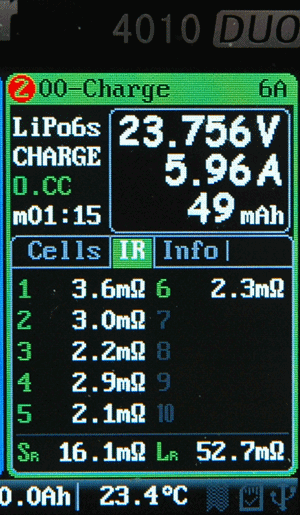 LiPo Internal Resistance Values In Milliohms
LiPo Internal Resistance Values In MilliohmsLiPo internal resistance (IR) is a useful measurement that all electric RC'ers should at least be aware of.
It's not the end all - be all, but it can certainly be used to gauge cell performance, efficiency, and what's important to many of us - Battery Health & Discharge Performance.
Internal resistance of both the LiPo battery and the individual cells within the battery is one of the very best ways to monitor your RC LiPo battery's condition.
By comparing brand new IR readings of the cells to ones you take thereafter as your LiPo pack/s age, you will have useful new vs. old condition data.
As far as I'm concerned, internal resistance of your LiPo's is such an important data set to monitor, yet it's rarely discussed.
So what exactly is the internal resistance of any battery?
All batteries no matter what the chemistry have an inherent resistance within them, thus internal. It's why batteries get warm when in use; that resistance to current flow is using up power in the way of heat generation.
A simple way to think of this internal resistance is how efficient the battery pack (and cells within the pack) are at flowing power from the battery to your model. The higher the internal resistance, the less efficient the pack is and the less current it can safely provide.
Just think of it in the same context as putting a big stinking resistor between your battery and your ESC/motor. The higher the resistive load is, the larger the voltage drop will be, and the more the resistor (the battery in other words) will heat up, and the slower your motor will run.
Internal resistance of LiPo batteries is measured in milliohms which is 1/1,000th of an Ohm, and is symbolized as mΩ.
What Are "Normal" LiPo Internal Resistance Values?
I get this question often and the answer is there is no "normal" or "best" value. There are variables that have a direct impact on internal resistance of a LiPo cell or battery including, but not limited to, capacity of the battery, quality of the battery, temperature of the battery/cell/s and the specific way you measure IR.
These variables contribute to IR values being all over the place; but there are some general rules:
- The smaller the capacity of the battery, the higher the internal resistance. For instance, most decent higher capacity LiPo cells (e.g. 5000 mAh) will have very low amounts of internal resistance when brand new. Numbers of 1 to 4 mΩ's (0.001 to 0.004 Ohm's) per cell when brand new at room temperature (72F / 22C) are typical. Smaller micro sized LiPo cells on the other hand will have higher resistances. It's not unusual to measure internal resistance numbers in the region of 150 mΩ on smaller 100 to 200 mAh micro park flyer LiPo cells when they are brand new.
- Generally, higher discharge rated packs will have lower internal resistance. Unfortunately "discharge ratings" are a marketing tool these days and can't be trusted. More on this in a bit!
- As LiPo packs are used and age, their internal resistance always increases.
So, the best way to use internal resistance (if your charger supports this very useful function) is to take an IR reading of your LiPo/s when it/they are brand new.
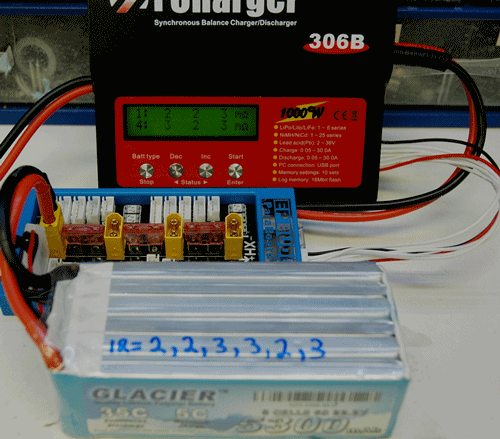 Recording & Marking New LiPo Internal Resistance Of Each Cell
Recording & Marking New LiPo Internal Resistance Of Each CellAs seen here, I will then record that mΩ number (the IR of each individual cell in the pack) somewhere on the pack with a permanent marker or label maker so I will always have a brand new IR base reference for that particular battery. I then put some clear tape over the numbers so they don't slowly rub off over time.
As this pack ages, or if I ever over-discharge it, I can simply reference how the resistance is increasing, or if one or more cells is/are getting ready to take a dump!
Consistent Temperature.
Another IR tip is to measure IR at the same temperature when you are comparing IR readings. As LiPo cells warm up, ion exchange efficiency increases, and therefore, the internal resistance decreases.
I try to take readings while packs are around room temperature (72 F / 22C ) as in that example above. If I took an IR reading right after a flight when that pack is "toasty", most of those cells would be reading 1 milliohm or less. If however I took the readings in a colder garage, they would be double or more; so resting temperature does have a big impact on your actual IR readings.
State of charge when taking IR readings.
I used to think state of charge had an impact of the IR readings because after fully charging a battery, the IR always seemed to be a little bit lower than when I started. However, what was causing that is the pack was slightly warmer after charging. I have since come to the conclusion state of charge doesn't cause much LiPo internal resistance variation.
I suggest taking your IR readings when the packs are around a 50% storage state (3.85V per cell) and have been sitting for at least an hour after charging or discharging to fully stabilize for the best overall consistency in, and between readings.
Use the same charger / measuring device.
Different chargers often give slightly different IR readings so I strive to use the same charger when I'm initially recording, and then later revisiting IR values of my packs.
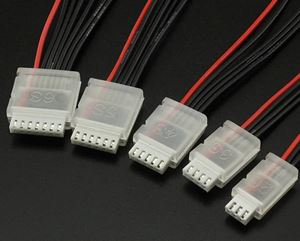 Balance Plug & Wiring Condition Can Impact Accuracy of LiPo IR Measurements
Balance Plug & Wiring Condition Can Impact Accuracy of LiPo IR MeasurementsGood wiring & connectors.
Balance wiring and connector condition is critical to obtain accurate IR readings.
We are talking milliohm (thousandths of an Ohm) measurements after all, and even a little corrosion or dirt on a connector pin can throw off a reading.
It never hurts to wiggle the balance wires or cycle the balance plug/board to see if the IR values fluctuate much between several readings; especially if you are getting weird or inconsistent numbers that you don't trust.
One last important point. You can only measure the internal resistance of a single battery at a time. You can't for example have several hooked up to a parallel charging board because the measured resistance values will be much lower due to Ohms law as it applies to resistance in parallel circuits.
How Do You Measure LiPo Internal Resistance?
This again is where good computerized chargers come into play. The good ones that support this feature will check the IR of each cell. They will have a special IR testing mode or will show the LiPo internal resistance while charging.
Most RC chargers use the "frequency method" (AC conductance); which is fast, but always gives lower IR values than when using the "DC load method" which some higher end chargers will employ. For more information on the various ways internal resistance can be measured, here's a good article.
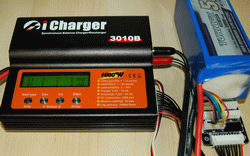 Measuring the internal resistance of each cell in this new 6S LiPo.
Measuring the internal resistance of each cell in this new 6S LiPo.Pictured here, I am taking the IR reading of each cell in this new 6S Turnigy LiPo using an iCharger RC battery charger that supports individual cell IR measurements.
It is hard to make out in the photo, but the IR of cells 1-6 are 2,2,1,1,1,2 mΩ each, giving a total IR for the entire pack of 9 mΩ; pretty respectable!
Using LiPo Internal Resistance To Calculate A Pack's Realistic Discharge C Rating
I briefly mentioned this on the LiPo Battery Ratings page, but this is perhaps one of the most useful applications of LiPo internal resistance I know of; using it to determine the safe maximum sustained discharge rate of any LiPo pack.
As we know from that LiPo Battery Ratings page, the most overstated and misleading number given by most LiPo battery manufacturers is the discharge C rating. It's almost always higher than it really is; sometimes by a lot!
I therefore use this formula:

You multiply the capacity of the battery by the highest cell IR reading in that pack, take the square root of that number and divide it into 2500 which will give a realistic continuous maximum C discharge rate for the pack.
Below is an example on a brand new Gens Ace 6S 5100 mAh pack. The pack was about room temperature (23C), and at storage state while taking the internal resistance readings of the cells.
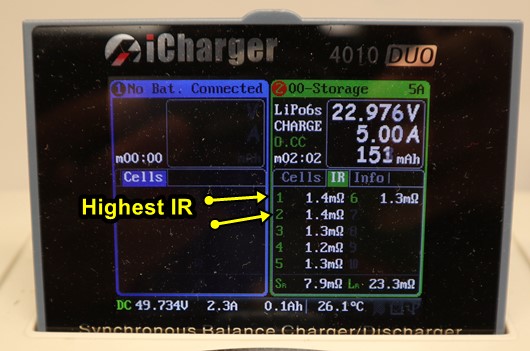 Using The Highest LiPo Cell Internal Resistance To Calculate The Maximum Safe Discharge Rate Of The LiPo Battery.
Using The Highest LiPo Cell Internal Resistance To Calculate The Maximum Safe Discharge Rate Of The LiPo Battery.So the highest cell/s IR in this 6S pack is 1.4 milliohms (cells 1 & 2). Multiply the packs capacity 5100 x 1.4 (IR) = 7140. Square root of that = 84.26. Divided into 2500 = 29.7
Let's call it a 30C rated pack.
30C x 5100 mAh = 153,000 mA or 153 Amps maximum continuous discharge rate. That is a fairly realistic value for this specific LiPo Pack.
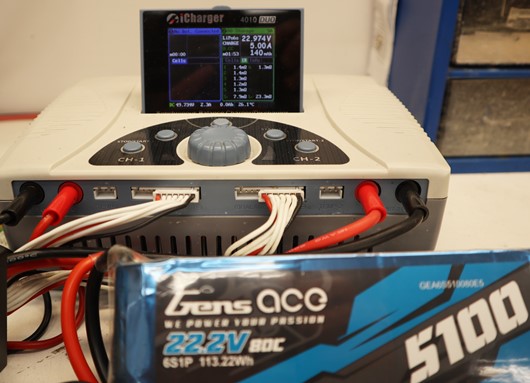 Overstated 80C Discharge Rate
Overstated 80C Discharge RateAs we can see from the above photo, that 30C / 153 Amp number is a far cry from the 80C rate on the label. Critical thinking skills to the rescue... If true, 80C would be 80 x 5.1A = 408 Amps! The 10 AWG wire would most likely glow red hot and vaporize as would the XT90 connector if 400+ Amps were passing through them.
Perhaps that 80C is a one time battery life ending current draw peak event if you shorted the wires together? The most extreme burst rating imaginable in other words; but not at all a safe or realistic sustained draw rating. It's nonsensical. It's also why any battery brand that boasts of 100C or higher C ratings, I just laugh at. Complete and utter marketing BS!
Honestly, any LiPo battery manufacturer stating a safe discharge rating much over 40C is blowing unicorn smoke!
Regardless of most LiPo brands' overstated and often outrageously dishonest C ratings, what I also like about this formula is you can use it as your packs age to know what kind of current you can still safely draw.
Just plug the higher IR values into the formula as your packs get older. Even if/when these packs are getting upwards of 5 milliohms per cell, that works out to about 15C, so I should still be able to get a usable 75 Amps out of them (fine for scale flying).
There are of course limitations with this C rate IR calculation method since it's only as accurate as the IR values you get, and as we know, IR readings can vary quite a bit.
However, it certainly gets you in the ball park with a reasonable maximum discharge rate that is more realistic than what is printed on most battery labels!
Most folks get pretty upset when they use this formula for the first time on their so called 130C rated packs that they paid a premium for to find out the real number is closer to 30C.
Calculating Total LiPo Internal Resistance & Battery Voltage Drop
For a single cell LiPo pack (1S), total internal resistance is simply the resistance of that one cell. For instance, a 1S LiPo cell showing 3 milliohms of IR would also have a total pack IR of 3 Milliohms.
A 2S or larger LiPo pack however, you have to add the IR of the cells together to get the total pack IR value.
Let's say we have a 6S pack with each cell having 3 milliohms of resistance. The total internal resistance of this pack will be 6x3 = 18 milliohms (0.018 Ohms).
Some RC chargers will indicate both individual cell internal resistance, and total pack internal resistance but not all.
Now that you have the total IR of the battery, you can calculate the voltage drop of the battery at any current load.
Using our 6S LiPo example above with the total pack IR of 18 milliohms, we now use good old Ohm's law (V = I x R).
The value of I is the current your RC model is drawing. This of course varies depending on the size/type of your model, how much throttle you are using and how hard you are flying or driving. Most of the time you would use the maximum current your model draws so you can get the maximum voltage drop it will experience.
So, let's just use a peak current of around 100 Amps for this example which is fairly common on a larger RC helicopter or EDF jet. Plugging that into our formula would be V = 100A x 0.018Ω giving us a peak voltage drop across the battery of 1.8 V.
So a 6S LiPo fully charged is about 25V. With a total IR of 18 milliohms, under a 100A load, the voltage output will drop to about 25V - 1.8V = 23.2 volts.
Other items in your RC power system will also increase this total voltage drop slightly such as the gauge of wire, length of wire and the RC connector type/health, but we are just focusing on voltage drop due to LiPo internal resistance here.
So what's this voltage drop number good for?
It's certainly not critical to calculate the battery voltage drop other than for your own curiosity. It can however be helpful to get you in the ball park when programming any sort of low voltage (LV) alarm/telemetry.
For instance, a low voltage alarm setting using that same 6S example with a 100A maximum current draw and having 12 milliohms total pack IR would be something like this.
An unloaded 6S battery at about a 75% discharged state (covered on the LiPo Charging page) will have an open circuit / no load voltage of about 22.5V. (3.75V per cell). Knowing that 1.8V drop at 100A, you could then set your LV alarm at 22.5 - 1.8 = 20.7 volts.
There are other variables as mentioned, but this will get you in the "ball park". I like playing it safe, and would set the alarm a little higher; maybe 21.0V but it totally depends on your specific battery, wiring, how hard you fly/drive and how much of a safety cushion you want for your LiPo pack/s if/when using alarms.
Regardless, and explained in depth on the LiPo Battery page, the only way to know for sure if your LiPo pack is not getting over discharged, is by checking it after flying/driving.
This is also why I still primarily time my flights over relying on the LV telemetry alarm; no question it's nice to have both, especially if (make that when) I have a brain fart and put a previously discharged battery in my bird which has certainly happened.
Anyway, main thing you get out of this is as LiPo battery packs are repeatedly used and age, their IR always increases, thus the voltage drop under load also increases and thus motor power is reduced. The pack will likewise run warmer while the maximum safe constant discharge current gets lower.
LiPo Internal Resistance Limitations
As mentioned, the specific method used to measure internal resistance will yield variable results.
In other words, it's always best to take internal resistance measurements with the same charger, at the same stabilized temperature, and if possible, at the same state of charge (ie. 50% storage capacity) when you are taking reading to calculate the packs C rating or making comparisons between values you took when the pack was new as it ages over time. All that will ensure consistency in your LiPo internal resistance readings if nothing else.
Don't confuse capacity of the pack with internal resistance either.
Internal resistance can climb as a pack ages, while the capacity of the pack may not degrade too much for example. In this instance, the efficiency of the pack will be lower than it was when new, but it still may safely provide as long a drive or flight assuming you are not pulling more current out of the pack than it can safely discharge with the efficiency drop. The reverse can also be true (drop in capacity while internal resistance remains low); but in my experience that is rare.
In short, LiPo battery internal resistance is just one more tool you have to monitor your LiPo battery's condition. Don't rely 100% on it thinking that as long as the IR remains low, the pack is guaranteed to be healthy; also monitor how much capacity the pack takes while charging it.
And once again, just like I mentioned on the LiPo Battery Ratings page, feeling the pack temperature after a flight or drive is still my main go-to method of determining how my LiPo's are aging. If one is getting noticeably warmer for the same type of flying than it used to get, that's reason to think about retiring it or use it in lower demand applications.
Several of my 6S LiPo packs for example that I can no longer use in my helicopters and EDF jets because they were simply getting too warm and the IR values were getting too high, I've re-purposed.
Pictured below for example, I'm using this tired 6S LiPo pack to power my little TS100 soldering iron which draws very little current (about 3 Amps max).
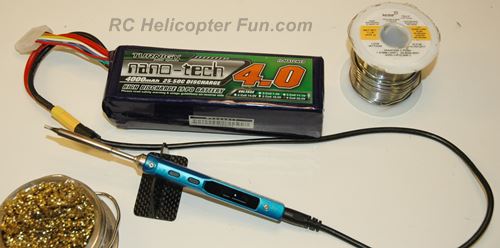 Safely using a "tired", high internal resistance LiPo pack in a low power application.
Safely using a "tired", high internal resistance LiPo pack in a low power application.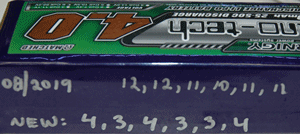 7 year old 6S LiPo IR values have pretty much tripled after many flights.
7 year old 6S LiPo IR values have pretty much tripled after many flights.This older and tired 6S pack doesn't get the slightest bit warm running the TS100.
For that low power demand application, it likely still has lots of life and charge cycles left.
The capacity is still good, and the IR values of the cells while about triple of what they were when new, are still all very close to each other telling me they are all aging equally and there isn't one or two that are ready to fail outright.
That's another important point; the IR values of the cells in your battery packs, both when new and as your packs age should all be fairly equal to each other. This is required for safe discharging and charging; your charger won't have to work its guts out balancing the battery. :)













